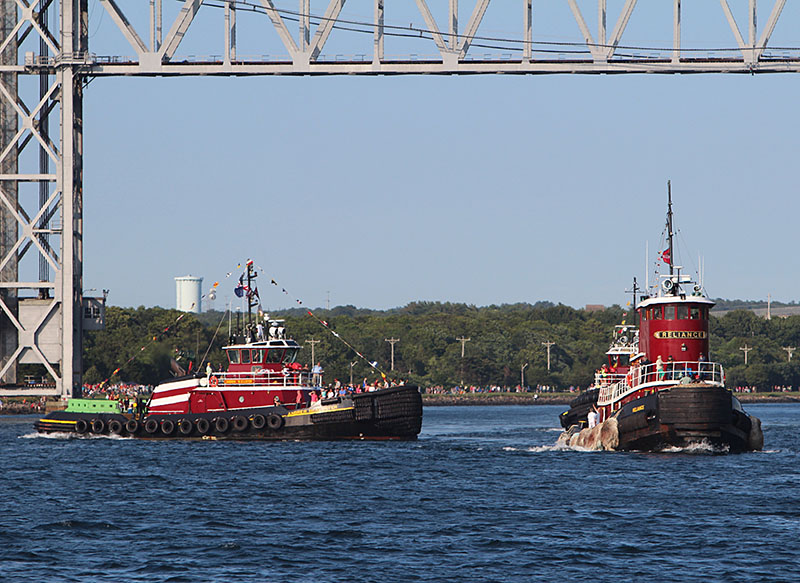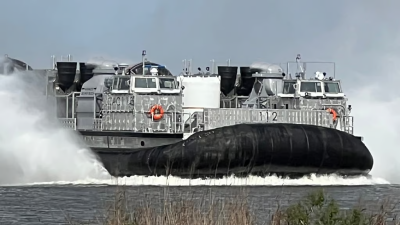When I’m on vacation, I like to combine a little history lesson with the beach visits. I’m especially hooked when the lesson involves maritime history.

The Cape Cod Canal Visitor's Center on a foggy day. Pamela Glass photo.
On a foggy and rainy day last week on Cape Cod, I was having lunch at Seafood Sam’s, a waterfront joint with a view of the Cape Cod Canal in Sandwich, Mass. To the left of the restaurant is a Coast Guard station, and directly in front is the Cape Cod Canal Visitor Center, run by the U.S. Army Corps of Engineers.
Bingo. My chance to get my history fix after fried haddock and cole slaw.
It's a fascinating place. Housed in a former Coast Guard boathouse, the center offers an overview of the canal’s construction and current day operations, using displays, interactive exhibits and public programs. You can view a film about how the canal was built, climb aboard a retired 40-foot patrol boat, navigate a virtual boat through the waterway (some readers may have navigated the real thing), and observe how the Corps’ marine traffic control system works. The center is also good publicity for the waterways industry, as it explains to visitors the importance of inland transportation. At one display, you can open the door of boxes displaying photos of different kinds of vessels that traverse the canal to see samples of the kinds of goods they carry: corn, petroleum, toys from China, automobiles, cruise passengers.

An exhibit at the Cape Cod Canal Visitor's Center shows the different types of workboats that traverse the waterway. Pamela Glass photo.
Opened in 1914, the 17.4-mile canal is a deep-draft, sea-level waterway. There are no locks, even though it connects two bays — Buzzards Bay and Cape Cod Bay — which have different tidal cycles and ranges. The shortcut shaves 135 miles off the trip between Long Island Sound and Boston and avoids the hazards of sailing in the North Atlantic to get around Cape Cod — an especially treacherous voyage in the winter. Historians believe there were as many as 3,000 shipwrecks along the outer shores of Cape Cod dating from colonial times into the 1900s.
The canal is spanned by two highway bridges — the site of non-stop summer traffic jams — a railroad bridge, and has a swift current that changes direction every six hours. It’s open 24 hours a day and is toll-free. It’s a busy waterway, with an average of 14,000 commercial and recreational vessels transiting it each year, and a hot spot for sport fishermen angling for the region’s coveted striped bass. The idea of a canal was first proposed in 1627 to facilitate trade with New Amsterdam. In the early years of the Revolutionary War, George Washington advocated for a canal to assure safe passage of U.S. ships. Other proposals floated around for the next century, but it wasn’t until two wealthy New York financiers got involved that ground was broken in 1909. It took five years to complete the project. The finished canal was not a success. It was narrow and shallow, and had tricky currents that were difficult for many commercial vessels to navigate. And there were tolls. Many shipping companies still opted to go around the Cape.
The canal came under government control during World Ware I after a German U-boat shelled a tug and its four barges rounding Cape Cod near Orleans in 1918. In 1928, the federal government officially purchased the canal for $11 million, and during the Great Depression in the 1930s put thousands to work widening and deepening it. Since then, operations and upkeep have been squarely in the hands of the Corps, which monitors traffic 24/7 using radar, radio signals and cameras.
Workboats are a common sight on the canal. After a major oil spill in Buzzards Bay in 2003, in which 81,000 gals. of No. 2 fuel oil spilled from a Bouchard barge that ran aground at the canal’s entrance, most large tank barges are required to have a tug escort with a local pilot onboard as they transit the canal.
But on this dismal day, it was hard to see beyond the canal’s edge. If there was a vessel out there, it was obscured by the thick fog and mist. Quite atmospheric, as it reminded me of what it must have been like in the early 1900s when dredges and workers dug the earth from each bay towards the middle, as bad weather, clay and the large boulders slowed their progress.
A great way to spend a rainy vacation day, grounded in the present with thoughts of the past.





